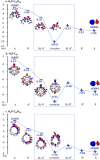External electric fields drive the formation of P → C dative bonds
- PMID: 40242842
- PMCID: PMC11997864
- DOI: 10.1039/d5sc01701g
External electric fields drive the formation of P → C dative bonds
Abstract
Chemical interactions driven by external electric fields (EFs) can serve as a catalytic force for molecular machines and linkers for smart materials. In this context, the EF-driven dative bond is demonstrated through the study of interactions between PH3 and curved carbon-based nanostructures. The P → C dative bonds emerge only in the presence of EFs, whereas the interactions in the absence of EFs lead to van der Waals (vdW) complexes. The formation of EF-driven dative bonds can be verified with distinctive signals in vibrational, carbon-13 NMR, and UV/vis spectra. The nature of EF-driven dative bonds was theoretically analyzed with the block-localized wavefunction (BLW) method and the associated energy decomposition (BLW-ED) approach. It was found that the charge transfer interaction plays a dominating role and that even in the presence of EFs, complexes dissociate to monomers once the charge transfer interaction is "turned off". Notably, the inter-fragment orbital mixing stabilizes the complexes and alters their multipoles, leading to additional stability through field-multipole interactions. This conclusion was supported by further decomposition of the charge transfer energy component, clarifying the precise role of orbital mixing. The inter-fragment orbital mixing, which occurs exclusively in the presence of EFs, was elucidated using "in situ" orbital correlation diagrams. Specifically, both external EFs and intermolecular perturbations remarkably reduce the energy gap between the frontier orbitals of the monomers, thereby facilitating inter-fragment orbital interactions. Significant covalency was confirmed through ab initio valence bond (VB) theory calculations of the EF-driven dative bonds, aligning with the crucial role of the charge transfer interaction. This pronounced covalency emerges as a key feature of EF-driven interactions, setting them apart from traditional dative bonds studied in parallel throughout this work.
This journal is © The Royal Society of Chemistry.
Conflict of interest statement
There are no conflicts to declare.
Figures






Similar articles
-
Hydrogen and Halogen Bonding in Homogeneous External Electric Fields: Modulating the Bond Strengths.Chemistry. 2021 Oct 7;27(56):14042-14050. doi: 10.1002/chem.202102284. Epub 2021 Aug 26. Chemistry. 2021. PMID: 34319620
-
A Unified Theory for the Blue- and Red-Shifting Phenomena in Hydrogen and Halogen Bonds.J Chem Theory Comput. 2017 Apr 11;13(4):1626-1637. doi: 10.1021/acs.jctc.6b01133. Epub 2017 Mar 14. J Chem Theory Comput. 2017. PMID: 28252964
-
Covalent vs. Dative Bonding in Carbon Monoxide and Other 10-Valence-Electron Diatomics.Molecules. 2024 Nov 15;29(22):5396. doi: 10.3390/molecules29225396. Molecules. 2024. PMID: 39598784 Free PMC article.
-
Solvent Effect on Dative and Ionic Bond Strengths: A Unified Theory from Potential Analysis and Valence-Bond Computations.Chemistry. 2024 Sep 19;30(53):e202402008. doi: 10.1002/chem.202402008. Epub 2024 Sep 6. Chemistry. 2024. PMID: 39031500
-
Energy decomposition analysis based on a block-localized wavefunction and multistate density functional theory.Phys Chem Chem Phys. 2011 Apr 21;13(15):6760-75. doi: 10.1039/c0cp02206c. Epub 2011 Mar 2. Phys Chem Chem Phys. 2011. PMID: 21369567 Free PMC article. Review.
Cited by
-
Structure Deformation, Spectral Properties, Reaction Activity of (ZnSe) n (n = 3 and 6) under the External Electric Field.ACS Omega. 2025 May 26;10(22):23591-23600. doi: 10.1021/acsomega.5c02451. eCollection 2025 Jun 10. ACS Omega. 2025. PMID: 40521478 Free PMC article.
References
-
- Calvaresi M. Martinez R. V. Losilla N. S. Martinez J. Garcia R. Zerbetto F. Splitting CO2 with Electric Fields: A Computational Investigation. J. Phys. Chem. Lett. 2010;1:3256–3260. doi: 10.1021/jz101005u. - DOI
-
- Papanikolaou P. Karafiloglou P. Investigating sigma bonds in an electric field from the Pauling's perspective: the behavior of Cl–X and H–X (X=C, Si) bonds. Theor. Chem. Acc. 2010;126:213–222.
-
- Rincón L. Mora J. R. Torres F. J. Almeida R. On the activation of σ-bonds by electric fields: A Valence Bond perspective. Chem. Phys. 2016;477:1–7. doi: 10.1016/j.chemphys.2016.08.008. - DOI
LinkOut - more resources
Full Text Sources
Miscellaneous

